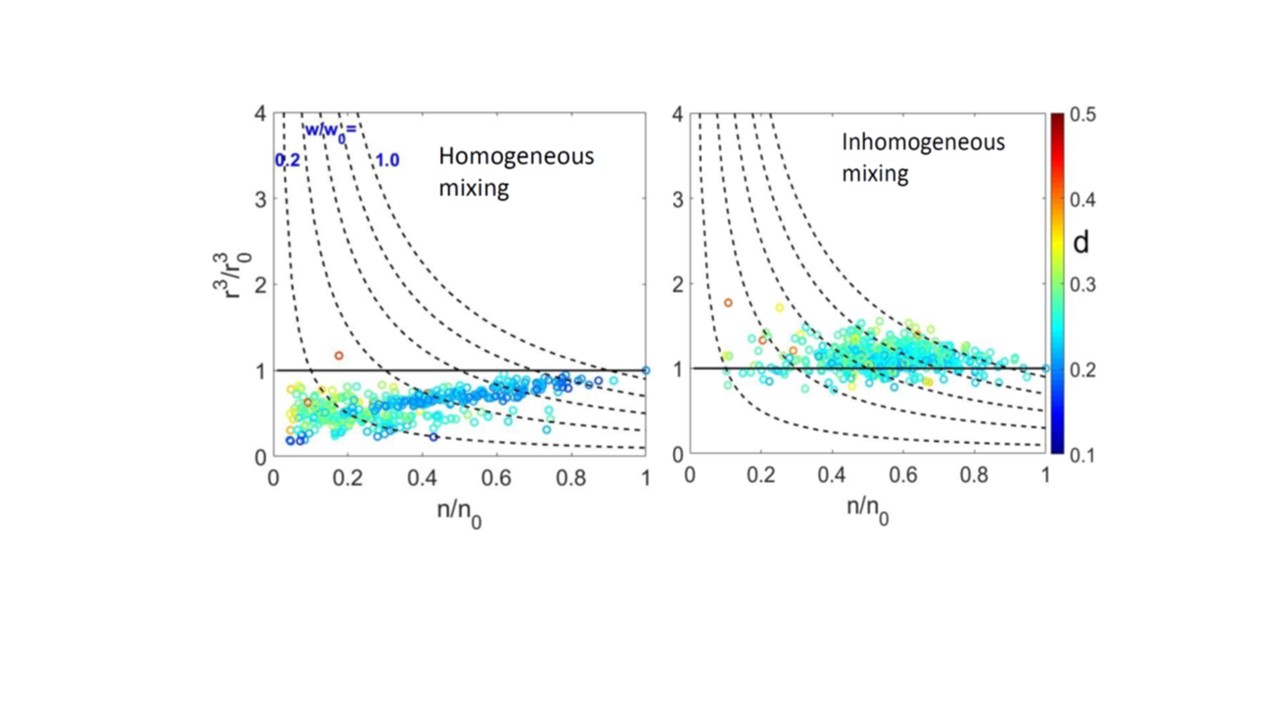Investigation of turbulent entrainment mixing with high-resolution digital holography
Submitter
Liu, Yangang — Brookhaven National Laboratory
Area of Research
Cloud-Aerosol-Precipitation Interactions
Journal Reference
Desai N, Y Liu, S Glienke, R Shaw, C Lu, J Wang, and S Gao. 2021. "Vertical variation of turbulent entrainment mixing processes in marine stratocumulus clouds using high resolution digital holography." Journal of Geophysical Research: Atmospheres, 126(7), e2020JD033527, 10.1029/2020JD033527.
Science

Figure 1. Mixing diagrams showing the normalized droplet number concentration on the x axis and normalized droplet volume on the y axis, where the normalization is relative to the least-diluted sample denoted by subscript “0”. The dotted lines represent constant liquid water content (w) lines with the ratio of w/w0, corresponding to the ratio of w in the holograms to that of the least-diluted sample. Data points represent the mean droplet volume and number concentration for each hologram during a cloud segment. The coloring corresponds to the relative dispersion (d) of the droplet population in the hologram, which is defined as the ratio between the standard deviation of the cloud droplet size distribution and cloud droplet average radius. The left and right plots compare the mixing diagrams near cloud base and near cloud top, showing homogeneous mixing near cloud base and inhomogeneous mixing near cloud top. From journal.
Turbulent entrainment-mixing processes have been proposed to explain outstanding cloud physics problems such as spectral broadening and rain initiation. However, investigations of these processes have been limited by the lack of high-resolution measurements and the apparent dependence of entrainment-mixing mechanisms on sampling scale. This study takes advantage of the cm-resolution measurements from the latest digital holographic technology to examine the vertical variation of entrainment-mixing mechanisms and the underlying physics.
Impact
Entrainment-mixing processes remain poorly understood, especially in the aspects of vertical variation, mechanisms at high resolution, and parameterization for atmospheric models. This study is the first attempt to address these three topics synergistically, paving the way for further exploration of these critically important issues in future.
Summary
Marine stratocumulus clouds contribute significantly to the Earth's radiation budget due to their extensive coverage and high reflectivity. Although these clouds are not very thick, turbulent entrainment-mixing can generate significant variations with altitude in cloud droplet number concentration, size, and relative dispersion, thereby affecting the radiative properties of the cloud. In this study, the vertical variability of turbulent entrainment-mixing processes and in-cloud microphysical properties are studied within a warm marine stratocumulus cloud layer. Unique high-resolution airborne holographic measurements and in situ turbulence measurements made during the Aerosol Cloud Experiments in the Eastern North Atlantic (ACE-ENA) field campaign were utilized for this purpose. We find that entrainment mixing near cloud top is primarily inhomogeneous, whereby droplet sizes vary much less than cloud droplet concentrations, and near cloud base the mixing is homogeneous, whereby droplet sizes vary significantly. The observed mixing mechanisms can be explained by a modified droplet evaporation time scale that we developed, which considers local saturation deficit within a simple linear mixing model. The study reinforces the importance of turbulent entrainment-mixing processes and use of appropriate microphysical time scales in determining cloud microphysical processes.
Keep up with the Atmospheric Observer
Updates on ARM news, events, and opportunities delivered to your inbox
ARM User Profile
ARM welcomes users from all institutions and nations. A free ARM user account is needed to access ARM data.


















